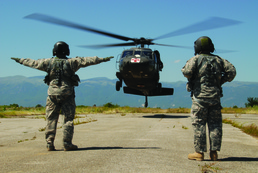
Standing on a forgotten, empty, wind-swept runway somewhere in Kosovo, Spc. Peter Grimm performed hand and arm signals in front of a UH-60 Black Hawk helicopter, adeptly directing the aircraft pilots to hover, move right or left, and finally take off in a specific direction of flight. Grimm, an aviation mechanic in training to become a UH-60 crew chief learned the proper motions from Staff Sgt. Aaron Patterson, standardization instructor from 1-169th Medical Evacuation company based in Johnstown, Pa.
Patterson, from Hastings, Pa., is teaching and evaluating Grimm and others through a program called Readiness Level, or RL progression. Enlisted members of the Army who are aviation mechanics or health care specialists have the opportunity to complete additional training to become crew chiefs or flight medics respectively. Candidates begin at an RL 3 status and work up to a fully qualified RL 1 status.
According to Patterson, crew chiefs and flight medics must wade through approximately 60 academic classes, written evaluations and perform numerous hands-on flight tasks. In addition, a portion of training involving night vision goggles is one of the final steps to become crew chief qualified. Depending on the unit’s mission, additional base tasks are required for medical evacuation companies and lift companies.
Grimm and other crew chiefs and flight medics in training have to be able to pass a flight physical, hold certain duty positions in aviation units and obtain state flight orders in order to begin the progression training. Grimm deployed with the 1-150th Aviation Battalion from Wheeling, W.Va., and is able to fulfill the requirements, thus was able to begin the process.
Grimm, a native of Charlestown, W.Va., said he came into the Army to fly. He said he is a fixed wing pilot back home and is glad to take the opportunity here to fly as much as possible and learn what he can before returning home. Grimm said he plans to attend the Aviation Warrant Officer courses after this deployment becoming a Blackhawk pilot himself.
During the same training flight in which Grimm led the Black Hawk pilots solely with hand and arm signals, he also responded to a simulated emergency situation in which a hard landing could have occurred requiring all passengers to vacate the aircraft to a safe distance and location. In addition, Grimm was required to perform numerous pre and post flight inspections as well as in-flight fuel management procedures and continually monitoring the surrounding airspace for possible obstacles. Under the watchful guidance of Patterson and Sgt. Jason Kling from Watsontown, Pa., flight medic with 1-169th, Grimm performed the tasks to standard.
Patterson said he truly enjoys training new crew chiefs and flight medics. “It’s rewarding to see people start out and really feel unsure or not really know if they can do this job, and take them from that point to bring them to a fully functioning mission crew chief or medic is exciting,” said Patterson. “I was a crew chief for a long time. I’ve done just about every job there is to do in aviation. I’ve had the advantage to be able to do this for so long, that I want to be able to pass that on.”
Patterson said he will continue to train crew chiefs and flight medics for the duration of the deployment and then return home to do the same. Grimm said he will garner as much training, experience and flight hours as he can here in Kosovo and looks forward to being able to translate those skills to a pilot seat in the aircraft he is learning to help guide and maneuver.
As Grimm stood tall against the rotor wash of the hovering Blackhawk helicopter; dust, leaves and grass blurring his vision, the confidence in his ability to perform the skills required to become a crew chief shone through the swirling debris. Patterson, on hand close by, was able to stand back and observe Grimm completing the required tasks to standard, well on his way to completing the RL progression training. The exchange of information from instructor to trainee illustrates the strength of the Army: experienced soldiers sharing their hard earned knowledge with upcoming troops willing to fulfill evermore challenging roles.